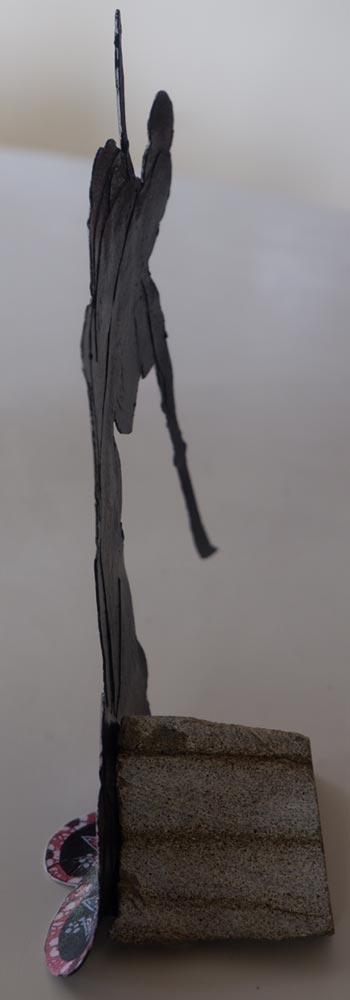![]() Latest work Sonja's c.v. Choose by Medium Prints A tour via thumbnail images
Latest work Sonja's c.v. Choose by Medium Prints A tour via thumbnail images

Digital print on 6 shaped layers of rag paper 240 gsm. Acrylic paint, gesso and varnish. Edition of 9.
Each work is a two part piece with a rock that is placed as a support and weight.
20 x 25 x 10 cm. This is a re-working of a 1848 woodblock print by Kuniyoshi Utagawa. (See: wikimedia.org)









A work on female empowerment.
The title points to a feminist reading first. She is a she first then a warrior or posed as a warrior.
When women are in a position to just be, first, then it means it is easier to focus on an access to a trade or skills, and help when needed.
I wanted to make a work that focussed first on the presence of a woman, and in this case, based on a historical woman, as a defender, fighter and mother.
In this work, the rock symbolizes society and each unique rock for each of the 9 in this limited edition uniquely affects each 'she' form it is placed next to.

She, onna-bugeisha, 2021, 2/9
The form can stand independently from the rock. The rock is there, like society is, as an aid to help each individual reach their potential.

She, onna-bugeisha, 2021, 2/9
Layers of rag card cut to suggest a build up of flowing shapes are painted with glossy black house paint as a play on shadow and form. 
She, onna-bugeisha, 2021, 3/9
Layers of gesso and varnish protect and create reflective surfaces on the 'she' form.

She, onna-bugeisha, 2021, 3/9
Edition information is written underneath the base of each print.
The illustration here is a re-working of a 1848 ukiyo-e style of woodblock print of Ishi-jo (wife of Ōishi Yoshio 1659-1703) wielding a naginata (pole with a sword at the end) by Kuniyoshi Utagawa (1798-1861).
(See: wikimedia.org)

She, onna-bugeisha, 2021, 3/9
The onna-bugeisha were female warriors in the Japanese upper class who were members of the bushi (samurai) class in feudal Japan. They were trained in the use of weapons to protect their household, family, and honor in times of war.
They are sometimes mistakenly referred to as female samurai but they existed before the emergence of the Samurai class as well as having status aside from combat or war.
For example, Empress Jingu (c. 169-269 AD), utilized her skills to inspire economic and social change. She is also reknown as the onna bugeisha who, according to legend, led an invasion of Korea in 200 AD without shedding a drop of blood.
This is an adaption of a 2013 work I made called Pop-Up Onna Bugeisha
Link to an article with images about Onna-Bugeisha from 167 AD to the last one, Nakano Takeko (1847-1869)

She, onna-bugeisha. L to R: 3/9, 2/9 and 1/9.

She, onna-bugeisha. L to R: 2/9, 3/9 and 1/9.

She, onna-bugeisha. L to R: 2/9, 3/9 and 1/9.

She, onna-bugeisha. L to R: 2/9 and 3/9.

Each 'she' form stands independently.
The rock is for extra support.